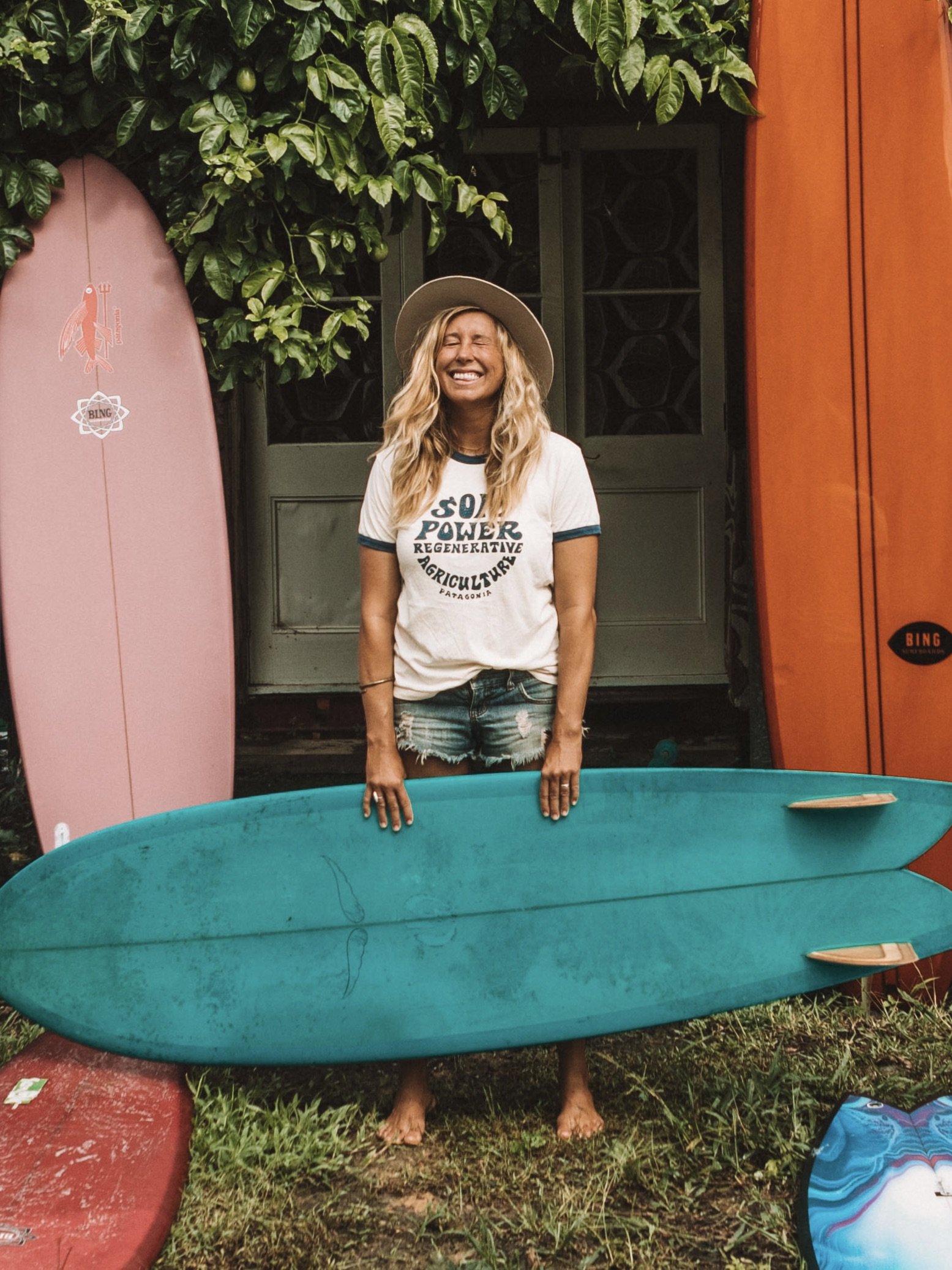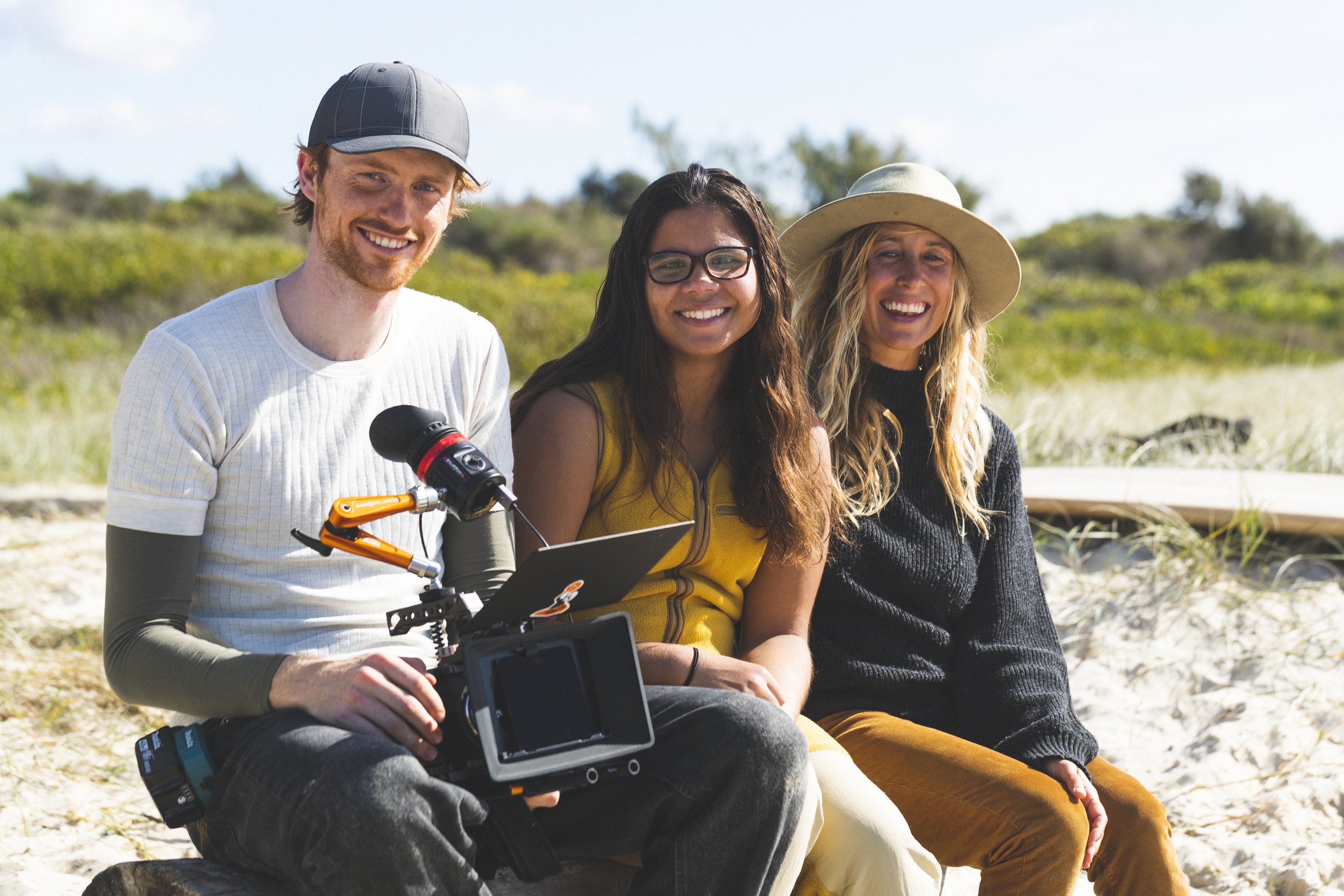Lauren Hill / The Physics of Noseriding
Interview by Glenn Sakamoto
Director Lauren Hill. Image courtesy Lauren Hill/Patagonia.
Lauren Hill is a Florida-born surfer, writer, podcaster, and filmmaker based in Byron Bay, Australia. She's won longboard surfing titles, writes about women’s surfing in her book She Surf, and co-hosts The Waterpeople podcast with partner Dave Rastovich. Lauren is also an advocate for sustainability and ethical living. Her new film, Physics and The Art of Noseriding has just been released. We spoke with Lauren to learn more.
What inspired you to create The Physics of Noseriding?
I’ve been surfing for more than 20 years, mostly riding longboards – and mostly chasing the particular sensation of levitation that you get with noseriding. It’s addictive.
It occurred to me that I didn’t really understand how noseriding works, or WHY that sensation of levitation is even possible. So, the film began with interviews with physicists and shapers, and the basic goal of better comprehending this thing that I’ve been doing, but not necessarily understanding cerebrally.
I wanted to use physics to articulate some of the forces at play during one of surfing’s peak moments.
Still from the film, The Physics of Noseriding. Image courtesy of Lauren Hill/Patagonia
How did you put together your team to begin filming?
I wanted to feature surfers I respect and admire; who I love to watch because they go steep and deep with their noseriding: Belinda Baggs, Ari Browne, Leah Dawson, Rosie Jaffurs, Lola Mignot, Josie Prendergast, Matt Cuddihy, Elise Trigger, Crystal Thornburg-Homcy, Dave Rastovich, Crystal Dzigas and Kelis Kaleopaʻa.
As for the technical team, I employed friends like Dave Homcy, Liam O’Brien and Nathan Oldfield to help capture the action. And I worked with an enthusiastic young filmmaker, Jai Anderson, to edit and help bring the fictional scenes together.
Filmmaker Jai Anderson, star Namaala Slabb, and director Lauren Hill on set. Image courtesy of Lauren Hill/Patagonia
Can you tell us about the young actor who is at the center of the film?
I wanted the protagonist to embody the youthful curiosity that we all have as kids. That many of us abandon for the efficiencies of adulthood.
I held castings for the role and ultimately chose Namaala Slabb, a local surfer, because I love how wonderfully awkward she is, and that she was never afraid to laugh at herself. She’s also at the start of her surfing life, so it made sense for her to be asking the questions that her character poses in the film.
Namaala had never acted before, or really been in front of a camera, and I had never directed before, so we were all allowed to make mistakes and have fun with every step of the process.
Namaala Slabb taking us along for the ride. Image courtesy of Lauren Hill/Patagonia
Namaala’s family, The Slabb’s, are renowned as one of the pillars of Indigenous culture in our region. They work to maintain their Bundajalung culture and language through initiatives like Juraki Surf, which Namaala’s dad, Joel, runs to create access opportunities for Indigenous kids to get into the water.
Parallel to the scientific explanations to Namaala’s questions in the film, I wanted to gently situate the science in the broader context of human thought.
Newtonian physics is a fascinating lens through which to see the world, but it’s only about 350 years old. As an immigrant to Australia, it felt appropriate to contextualise the science within the understanding that Indigenous Australians represent the oldest living human culture, and were very probably amongst the first wave riders.
Namaala, and her family, are part of the living legacy of knowledge systems that predate what many of us accept as irrefutable – “science” – by 10s of thousands of years. That isn’t my story to tell at length, but it felt important to at least acknowledge other knowledge systems in the film.
Lola Mignot gracefully demonstrates the Hang Hip. Image courtesy of Lauren Hill/Patagonia
We learn that women surfers use their hips while on the nose. Can you tell us more?
Men and women tend to have different physiologies to work with, and so it makes sense that we adapt to the wavescape in differing ways, generally speaking.
I find the comparison between men’s and women’s surfing boring and unnecessary.
What I do find interesting are the general tendencies (there are always outliers) for male bodies to do something like noseriding in a particular way, and that female bodies often do that thing in a different way. Both are functional, but celebrating that difference felt worthwhile for some screen time.
If we look to the most skilled nasal navigators, particularly those surfing backhand, and especially those who really push into critical sections – like Lola Mignot, Belinda Baggs, Kassia Meador, Josie Prendergast, etc. – what we find is a willingness to push the leading hip out beyond the nose. It is an underappreciated, full commitment swing of the weight. The “hang hip,” if you will. I wanted to celebrate that subtle manoeuvring.
I’ve been challenging everyone who sees the film to try it themselves.
Still from the film featuring Josie Pendergast. Image courtesy of Lauren Hill/Patagonia
What were some of the obstacles during production?
You can’t force good surfing footage – it’s an unfakable confluence of the right conditions, the right surfer, and then being in the right place at the right time to capture moments on a wave that are impossible to recreate. This is the challenge, but also the fun of making a surf film.
The extra layer of challenge for this project was trying to illustrate the particular ways that the rail engages with water – showing how water wraps and curls, lifts and unfurls – during high speed technical noseriding, to explain the physics behind that engagement. We had to experiment with different cameras, build one-off mounts, and wait for the water quality to be clear enough to show what was really happening.
“I wanted to make a little homage to the intricacy of noseriding. The true experts do it with grace and ease, not because it’s easy, but because they are very sensitive and skilled at reading water.”
What lessons did you learn before, during and after the production?
The overarching lesson: filmmaking is a black hole of time, energy and money. I have the deepest appreciation for people who do it well.
What were you hoping to fulfill in the minds of your audience?
I wanted to make a little homage to the intricacy of noseriding. The true experts do it with grace and ease, not because it’s easy, but because they are very sensitive and skilled at reading water.
Director Lauren Hill practices watch she teaches. Photo by Beatriz Ryder.
What has been the reaction to your film during screenings?
It’s always a little intimidating when you make something and then release it into the world for others to see, judge, critique. But we’ve had a remarkably warm reception. People seem delighted to see surfing framed a little differently on the screen.
We’ve held live screenings in the US, Australia, The Philippines, Hawaii, Mexico, Costa Rica and more, so the success of gathering with our global community of surf nerds has felt sweetly fulfilling – especially after the COVID years.
What’s next for Lauren Hill, filmmaker?
I’m developing a longer story for the screen that’s in the genre of historical fiction; I hope to reimagine an underappreciated figure from the surfing timeline.
In the meantime, I’m back to working on The Waterpeople Podcast, refining a few book proposals, and spending sweet ocean time with my family.
The Physics of Noseriding can be viewed here. Follow Lauren on Instagram here. Listen to The Waterpeople Podcast here.







